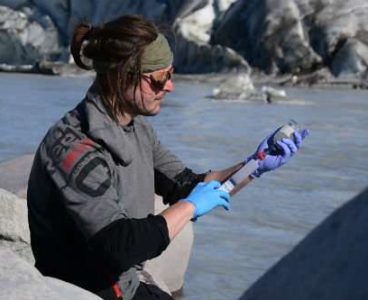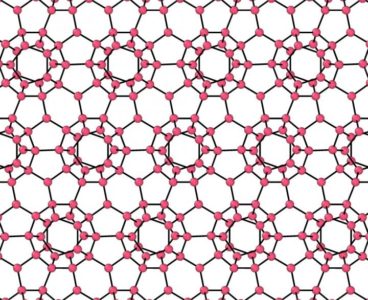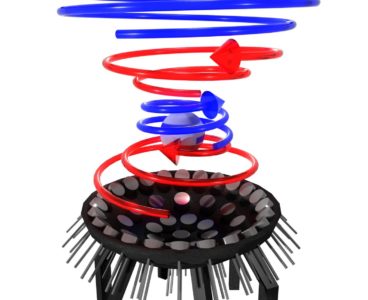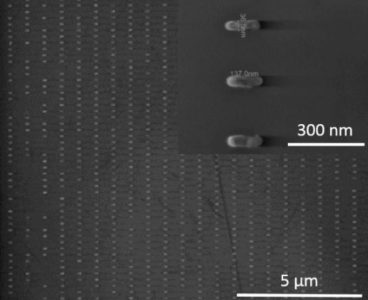
Protocells Utilize DNA Logic to Communicate and Compute
Researchers at the University of Bristol, Eindhoven University of Technology and Microsoft Research have successfully assembled communities of artificial cells that can chemically communicate and perform molecular computations using entrapped DNA logic gates. The work provides a step towards chemical cognition in synthetic protocells and could be useful in biosensing and therapeutics. Molecular computers made…
Giant Impacts Caused by interplanetary Collisions
Astronomers have found fresh evidence for significant planetary diversity within a single exoplanet system, suggesting that giant high-speed collisions are partly responsible for planetary evolution. An international team of scientists led by Italy’s National Institute for Astrophysics (INAF) and involving physicists from the University of Bristol spent three years observing the exoplanetary system Kepler-107 via…
Melting Ice Sheets Release Tons of Methane into the Atmosphere
The Greenland Ice Sheet emits tons of methane according to a new study, showing that subglacial biological activity impacts the atmosphere far more than previously thought. An international team of researchers led by the University of Bristol camped for three months next to the Greenland Ice Sheet, sampling the meltwater that runs off a large…
Location of Large Mystery Source of Banned Ozone Depleting Substance Uncovered
Ice Sheets of the Last Ice Age Seeded the Ocean With Silica
New research led by glaciologists and isotope geochemists from the University of Bristol has found that melting ice sheets provide the surrounding oceans with the essential nutrient silica. Silica is needed by a group of marine algae (the microscopic plants of the oceans) called diatoms, who use it to build their glassy cell walls (known…
Tie a Knot to Find the Hole
Laser light may appear to be a single, tightly focused beam. In fact, it’s an electromagnetic field, vibrating in an ellipse shape at each point in space. This multidirectional light is said to be “polarized.” The effect can be seen with polarized sunglasses, which only allow one direction of light to penetrate. By holding them…
Polymer Crystals Hold Key to Record-Breaking Energy Transport
Scientists from the universities of Bristol and Cambridge have found a way to create polymeric semiconductor nanostructures that absorb light and transport its energy further than previously observed. This could pave the way for more flexible and more efficient solar cells and photodetectors. The researchers, whose work appears in the journal Science, say their findings…
Robotic Skin Inspired by Luke Skywalker’s Hand
Scientists at the University of Bristol are engineering human skin on artificial robotic muscles that can stretch and bend the tissue just like in the real world. This living and moving skin equivalent represents a much more realistic model of human skin and it could have potential applications for burns patients needing skin grafts. Currently,…
Weather Forecast Model Predicts Complex Patterns of Volcanic Ash Dispersal
New research, led by the University of Bristol, has provided fresh insight into how huge volcanic ash plumes, which can critically disrupt aviation and cause major impact on the ground, are transported in the atmosphere. In 2010, the eruption of the Icelandic volcano Eyjafjallajkull caused widespread travel chaos, with the cancellation of more than 100,000…
Common Seaweed Forms New Type of Opal
Scientists have discovered a completely new type of opal formed by a common seaweed which harnesses natural technology by self-assembling a nanostructure of oil droplets to control how light reflects from its cells to display a shimmering array of colors that until now, has only been seen in the gemstone. The findings, published in Science…
Understanding the Strange Behavior of Water
The properties of water have fascinated scientists for centuries, but yet its unique behaviour remains a mystery. Published this week in the journal Proceedings of the National Academy of Sciences of the United States of America, a collaboration between the Universities of Bristol and Tokyo has attempted a novel route to understand what makes a liquid behave…
Study Explains How Organisms Evolve to Live at Different Temperatures
The brilliant physicist Richard Feynman famously said that, in principle, biology can be explained by understanding the wiggling and jiggling of atoms. For the first time, new research from the University of Bristol, UK and the University of Waikoto, New Zealand explains how this ‘wiggling and jiggling’ of the atoms in enzymes – the proteins…
Nanocrystalline Graphite Powers New Group of Harsh Environment Electronics
Researchers from the Universities of Bristol and Southampton, in collaboration with Microsemi, have demonstrated reliable operation of microelectromechanical relays by coating the contacts with nanocrystalline layers of graphite, to enable ultra-low-power electronics for harsh environments. Micro and nanoelectromechanical relays have effectively zero leakage current and can operate at much higher temperatures and levels of radiation…
The World’s Most Powerful Acoustic Tractor Beam Could Pave the Way for Levitating Humans
Optically Tunable Microwave Antennas for 5G Applications
Multiband tunable antennas are a critical part of many communication and radar systems. New research by engineers at the University of Bristol has shown significant advances in antennas by using optically induced plasmas in silicon to tune both radiation patterns and operation frequency. Conventional antenna tuning is performed with diodes or Micro-Electro-Mechanical Systems (MEMS) switches.…
Nanoantenna Arrays Power a New Generation of Fluorescence-Based Sensors
Researchers from the Universities of Bristol and Bedfordshire, in collaboration with multinational company ABB, have designed and tested a series of plasmonic nanoantenna arrays that could lead to the development of a new generation of ultrasensitive and low-cost fluorescence sensors that could be used to monitor water quality. The arrays, designed and tested by Dr…
Future Smartwatches Could Sense Hand Movement Using Ultrasound Imaging
Scientists Pinpoint the Singularity for Quantum Computers
Researchers from the University of Bristol have discovered that super-powerful quantum computers, which scientists and engineers across the world are racing to build, need to be even more powerful than previously thought before they can beat today’s ordinary PCs. Quantum computers are a new type of machine that operate on quantum mechanical hardware and are…
Protein Cages May Have Applications in Nanotechnology and Synthetic Biology
A multidisciplinary team from the Bristol BioDesign Institute has come together to study the self-assembly of protein building into protein cages, leading to new research which has potential applications in nanotechnology and synthetic biology. The paper: Beyond icosahedral symmetry in packings of proteins in spherical shells, describes theoretical work and numerical simulations by a team…
Formation of Porous Crystals Observed for the First Time
Scientists at the University of Bristol have, for the first time, observed the formation of a crystal gel with particle-level resolution, allowing them to study the conditions by which these new materials form. The study showed that the mechanism of crystal growth follows the same strategies by which ice crystals grow in clouds, an analogy…
Microbial Colonizers of Arctic Soils Are Sensitive to Future Climate Change
A team of researchers from the University of Bristol have recently shown that ecosystems created by melting glaciers in the Arctic are sensitive to climate change and human activity. Melting ice is exposing vast landscapes that are colonised by simple forms of microbial life. These microbes in Arctic soils must cope with short cool summers…
Bristol, BT Collaborate on Massive MIMO Trials for 5G Wireless
The quest for highly efficient 5G wireless connectivity has been given a boost thanks to a collaboration between a team of 5G engineers from the Universities of Bristol and Lund, National Instruments (NI), and BT, one of the world’s leading providers of communications services. The research team has undertaken field trials of a massive MIMO…
Spiny, Armored Slug Reveals Ancestry of Mollusks
Scientists from the University of Bristol have uncovered a 480-million-year-old slug-like fossil in Morocco which sheds new light on the evolution of molluscs – a diverse group of invertebrates that includes clams, snails and squids. One of the defining characteristics of the molluscs is the possession of a radula, a kind of toothed-tongue which is…



















